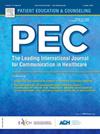Improving value of care for renal cell carcinoma patients; development of a decision aid for metastatic clear-cell renal cell carcinoma
IF 2.9
2区 医学
Q2 PUBLIC, ENVIRONMENTAL & OCCUPATIONAL HEALTH
引用次数: 0
Abstract
Objective
Patient decision aids (PtDAs) can support shared decision-making (SDM) by providing information about options, pros and cons and eliciting personal preferences. The aim of this study was to develop and test the acceptability and usability of a PtDA for patients with metastatic clear-cell renal cell carcinoma (RCC), the most common type of metastatic kidney cancer.
Methods
User-centered mixed methods design. Co-creation process with stakeholders guided by the International Patient Decision Aids Standards (IPDAS) criteria, consisting of three main elements: (a) a needs assessment; (b) acceptability and usability testing; and (c) compatibility assessment with IPDAS criteria.
Results
Thirteen RCC patients and 29 healthcare professionals (HCP) participated in this study. Co-creation sessions were held with nine HCPs and a patient representative. Needs assessment (a) showed that patients lacked real treatment choices and wanted information on all treatment options, including life expectancy, side effects, psychological, and lifestyle advice. HCPs expect a PtDA to improve information delivery and patient engagement. A three-component PtDA was developed and tested (b), with positive feedback from both patients and professionals. The tool meets all 12 IPDAS criteria (c).
Conclusions
The web-based PtDA was developed and adapted to address unmet needs and found to be acceptable and usable by patients and HCPs.
Practice implications
The use of this tool could contribute to high quality, patient-centered and appropriate care for metastatic clear cell RCC patients in the Netherlands.
提高对肾癌患者的护理价值一种转移性透明细胞肾细胞癌决策辅助工具的研制
目的患者决策辅助工具(ptda)可以通过提供选择、利弊信息和激发个人偏好来支持共同决策(SDM)。本研究的目的是开发和测试PtDA对转移性透明细胞肾细胞癌(RCC)患者的可接受性和可用性,RCC是最常见的转移性肾癌。方法以用户为中心的混合方法设计。在国际患者决策辅助标准(IPDAS)标准指导下与利益攸关方共同创建过程,包括三个主要要素:(a)需求评估;(b)可接受性和可用性测试;(c)与IPDAS标准的兼容性评估。结果13例RCC患者和29名医护人员(HCP)参与了本研究。与九名医护人员和一名患者代表举行了共同创作会议。需求评估(a)表明,患者缺乏真正的治疗选择,并希望了解所有治疗方案的信息,包括预期寿命、副作用、心理和生活方式建议。HCPs期望PtDA能够改善信息传递和患者参与。开发并测试了三组分PtDA (b),并获得了患者和专业人员的积极反馈。该工具满足所有12项IPDAS标准(c)。基于网络的PtDA被开发和调整,以解决未满足的需求,并被患者和HCPs接受和使用。实践意义在荷兰,使用该工具可以为转移性透明细胞RCC患者提供高质量、以患者为中心和适当的护理。
本文章由计算机程序翻译,如有差异,请以英文原文为准。
求助全文
约1分钟内获得全文
求助全文
来源期刊

Patient Education and Counseling
医学-公共卫生、环境卫生与职业卫生
CiteScore
5.60
自引率
11.40%
发文量
384
审稿时长
46 days
期刊介绍:
Patient Education and Counseling is an interdisciplinary, international journal for patient education and health promotion researchers, managers and clinicians. The journal seeks to explore and elucidate the educational, counseling and communication models in health care. Its aim is to provide a forum for fundamental as well as applied research, and to promote the study of organizational issues involved with the delivery of patient education, counseling, health promotion services and training models in improving communication between providers and patients.
 求助内容:
求助内容: 应助结果提醒方式:
应助结果提醒方式:


